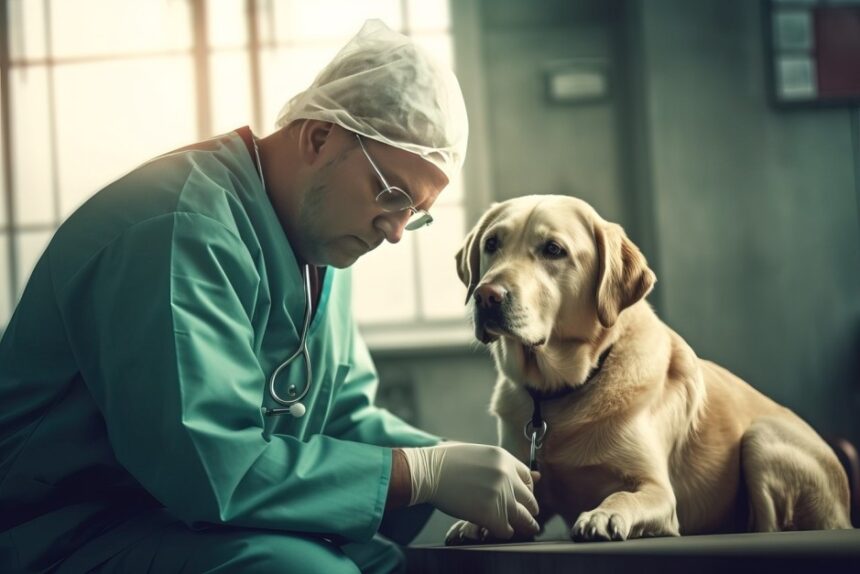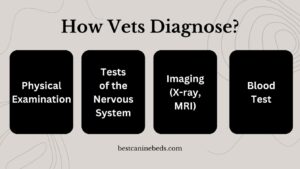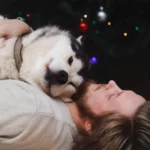A dog’s leg tremors are usually muscle tremors. Leg tremors can be mild or severe. It can occur in one dog’s leg or in all four legs. It is important to understand the cause of leg tremors by considering your dog’s health and walking style.
- It can cause weakness and tremors in the legs due to pain.
- Conditions affecting the brain or spinal cord can cause tremors.
- Low blood sugar or organ problems can manifest as tremors in a dog’s leg.
- In some cases, leg jerks can also be caused by too much excitement.
Dog Health
- Better care: In this, we can provide proper care by understanding the natural behavior and food needs of the dog. Taking care of their needs, such as playing, jumping, eating, drinking, and exercising. Choosing food according to the breed and age of the dog Very important.
- Early detection of problems: Observing a change in a dog’s behavior can indicate a health problem. If the dog is experiencing a loss of appetite and starts barking involuntarily, this change is serious. Early detection can often lead to better treatment.
- Meeting their needs: Just like humans, dogs have physical and mental needs such as food, exercise, and peace of mind for good health. Providing a calm environment for dogs is very good for their health.
- Stronger Bond: Understanding what dogs say and their behavior builds a good and strong bond between you and your dog. The way you interact and play with it improves the training experience and has a profound effect on confidence and health.
What Causes Canine Leg Tremors?
Muscle and Joint Issues:
- Arthritis: Pain and inflammation in most joints is a common condition in older dogs. In dogs, this pain usually manifests as tremors.
- Muscle Weakness: It can become difficult for dogs to control their movements, leading to tremors and muscle weakness due to various conditions such as rabies infection and nerve weakness.
Nerve Problems:
- Degenerative Myelopathy: This disease usually occurs in large-breed dogs, such as German Shepherds and other large-breed dogs. It is a progressive disease of the spine. This disease can be present in dogs with tremors, weakness, and difficulty walking.
- Shaker syndrome is a whole-body tremor in small dogs. It is considered an autoimmune disease.
Metabolic Factors:
- Electrolyte Imbalances: Electrolytes are minerals in the blood that help muscles and nerves function properly. Electrolyte imbalances, in general, can cause seizures.
- Diabetes: High blood sugar levels affect the body’s ability to. low blood sugar, which can cause weakness and seizures.
Other Factors:
- Injury: Seizures may result from trauma to the brain, muscles, or nerves.
- Autoimmune disorders: These are situations where the immune system of the body targets healthy tissue. Tremors can be brought on by some autoimmune diseases that impact the neurological system.
Recognizing Symptoms
- Dogs’ visible symptoms, such as shivering or trembling of the legs, might point to a number of issues, including pain or discomfort. A dog’s legs shaking may indicate physical discomfort, fear, worry, or even excitement.
- such as adjustments to gait or posture, to gain a deeper understanding of your dog’s emotions. In order to rule out any underlying medical concerns and appropriately treat your dog’s health, see a veterinarian if you observe these symptoms on a regular basis or if they are accompanied by other associated behaviors. is superior.
How Veterinarians Diagnose
- Physical exams: An examination of the dog’s body, including its weight code, lymph nodes, lungs, teeth, gums, skin, eyes, ears, heart, genitals, etc. The vet will also observe the dog’s gait and posture.
- Tests of the Nervous System: These exams evaluate how well the dog’s nervous system is operating. Assessing the dog’s reflexes, muscular strength, coordination, and mental state are a few examples of these.
- Imaging (X-ray, MRI): Image tests are used to see the internal organs of dogs. In X-rays, we can see the image of bones and some other tissues in dogs. MRIs are used to create detailed images of bones and can be visualized using radio waves.
- Blood Work: A blood test is used to assess a dog’s overall health for disease scans. Blood tests can measure proteins and other substances in the blood cells.
Treatment Approaches
- Medicine for pain relief: Medications can be given to dogs to relieve pain. such as nonsteroidal anti-inflammatory drugs (NSAIDs), opioids, or other analgesics to alleviate discomfort. The choice of medication depends on the severity of the pain and the specific condition of the dog.
- Physical Therapy: Criticisms of physical therapy for dogs, such as stretching or massage, include hydrotherapy, which can help reduce pain and increase muscle strength to improve mobility in dogs.
- Surgery for Severe Cases: In more severe cases, such as major orthopedic problems or conditions such as hip dysplasia, surgery is necessary to address the underlying issues and improve the dog’s quality of life.
- Assistive Devices: Wheelchairs, Harnesses: Assistive situations include harnesses and wheelchairs that can help the dog move around. For example, a wheelchair is best for supporting dogs with hind limb weakness, while a harness helps the dog walk or provides support when standing.
Role of Dog beds in preventing trembling
- Comfort and Support: It is important to provide a comfortable dog bed and a comfortable place to sleep. Orthopedic dog beds provide comfort as well as reduce pain in your dog’s knees.The luxurious fabric of this bed helps reduce their joint pain.
- Warmth: Dogs need warmth in cold weather. Use a calming dog bed to keep them cozy and warm.
- Security and Relaxation: Canines much of the time search for a feeling of wellbeing and security the Scruffs expedition dog bed provides in their environmental factors. Laying out an extraordinary, serene region for them to resign to can support bringing down pressure and tension.
- Prevention of Pressure Sores: Like people, canines might foster strain wounds from expanded time frames spent leaning back on hard surfaces. Giving them durable, sensitive sheeting and permitting them to move positions every now and again will assist with keeping these injuries from creating.
- Promoting Better Sleep: Canines need bettersleep, which is crucial for their general wellbeing and prosperity, Western home calming dog beds provide a comfortable and safe sleeping climate. Laying out a rest routine, guaranteeing a tranquil and agreeable region for them to rest, and integrating routine exercises into their everyday schedule can all add to more readily rest quality.
Extra Care for Your Dog
- Ensure the situation your canine is in right now is satisfactory and utilitarian. To assist with easing joint strain in regions where your canine exhausts a great deal of energy, utilize delicate sheet material there.
- Developing canines might battle with lopsided ground surfaces, which can prompt mishaps and wounds. To further develop a foothold, contemplate utilizing floor coverings or matting, particularly in regions where your canine regularly visits strolls.
- In the event that your canine experiences difficulty going onto furniture or mounting steps, you might need to give a few slants or different developments to assist them with investigating the house all the more without any problem.
- More experienced canines might require a particular eating regimen. Counsel your veterinarian about the ideal timetable for your canine, thinking about things like joint wellbeing and weight.
- Despite the fact that more established canines probably won’t be essentially as spry as they used to be, it’s still critical to keep them dynamic to keep up with joint adaptability and solid strength. Delicate strolls and low-influence practices custom fitted to your canine’s capacities can be helpful.
- Regular veterinary exams are significant for checking your canine’s wellbeing and resolving any age-related issues that might emerge. This incorporates dental thought, which is significant for by and large prosperity yet is now and again disregarded.
- Like with people, developing can be hard for canines. Show them a lot of adoration, care, and solace to assist with facilitating any nervousness or disarray they might insight.
- Invest significant energy taking part in exercises your developing canine appreciates, like delicate play or just discreetly sitting close to one another. This helps your pet feel far improved and fortifies your bond.
Key Takeaways
In relation to the health and success of dogs. Early detection of any health issues is important for effective treatment across the board. Just like with individuals, addressing problems early often leads to better outcomes. Seeking advice from a veterinarian as soon as possible can make a big difference in your dog’s health.
Moreover, proper management plays a crucial role in maintaining a reasonable level of personal fulfillment for dogs, especially if they have chronic conditions or age-related problems. This could involve medication, special diet plans, exercise routines, or other forms of care tailored to your dog’s specific needs. Making sure your furry friend receives the proper care can have a profound impact on their happiness and comfort.
Conclusion
There are various elements that could cause canine leg shakes going from typical events like chilly climate to additional difficult circumstances like injury or neurological issues. Albeit different incidental effects might go with leg quakes relying upon the reason, it’s critical to see their event and any going with side effects to guarantee your canine gets fitting analysis and treatment.
FAQs
Why do my dog’s back legs quiver?
The hind legs of the dog tremble from weakness. A dog can also have symptoms of injury or chronic illness for any number of reasons. Exercising all day can make a dog’s legs tired and shaky.
Should I be worried if my dog is trembling?
If your dog is shivering, it could be a sign of something more serious, such as kidney disease, injury or poisoning. If any other symptoms are present, such as vomiting, diarrhea, or unusual behavior. Then talk to your doctor right away.
Why is my dog’s hind leg twitching?
It could very easily be a simple muscle spasm from misuse, dehydration, or even something as trivial as being cold. It might also be a sign of a more serious illness, such as nerve damage, a neurological issue, or even a poisoning reaction.
How to treat tremors in dogs?
Tremor syndrome can be treated with drugs to suppress the immune system.
Should I be worried if my dog’s leg is shaking?
Leg shaking is especially common in older dogs and can be a sign of muscle weakness, however, frequent shaking can indicate underlying health problems.












